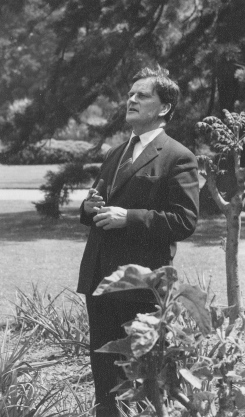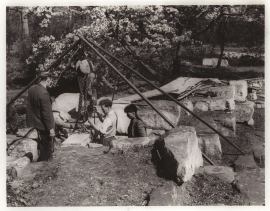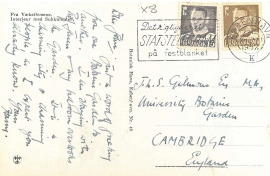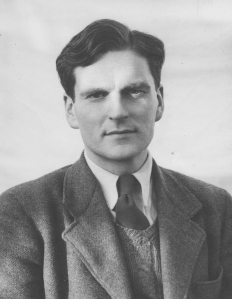 John Scott Lennox Gilmour, MA 1906 – 1986
John Scott Lennox Gilmour, MA 1906 – 1986
Director of the Botanic Garden 1951 – 1973
Plant Taxonomist, Horticulturist, Conservationist, Author, Editor, MA Cantab, Fellow of The Linnean Society (FLS)
Education
Downs School, Malvern
Uppingham School, Rutland
Clare College, Cambridge
Career & Prizes
1930 – 1931 Curator of the Herbarium and Botanical Museum, Botany School, Cambridge University
1931 – 1946 Assistant Director, RBG, Kew
1946 – 1979 Editor of the New Naturalist
1946 – 1951 Director, RHS Wisley
1951 – 1973 Director, Cambridge University Botanic Garden
1957 RHS Victoria Memorial of Honour
1966 RHS Veitch Memorial Medal
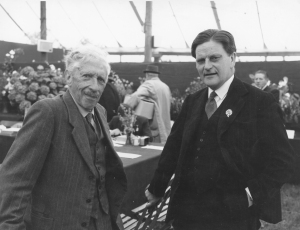 John Scott Lennox Gilmour is an important figure in the physical and ideological shaping of the new eastern section of the Cambridge University Botanic Garden. The unlocking of vital funds through the Cory Fund was matched by John Gilmour’s enthusiasm, energy and botanical scholarship. Gilmour succeeded Gilbert-Carter in 1951 and – together with Superintendent, Bob Younger – the horticultural team began to transform the eastern garden. In 1957, the Cory Laboratory and glasshouses were constructed. These major developments were thanks to a generous bequest from wealthy Trinity College alumnus, Reginald Cory.
John Scott Lennox Gilmour is an important figure in the physical and ideological shaping of the new eastern section of the Cambridge University Botanic Garden. The unlocking of vital funds through the Cory Fund was matched by John Gilmour’s enthusiasm, energy and botanical scholarship. Gilmour succeeded Gilbert-Carter in 1951 and – together with Superintendent, Bob Younger – the horticultural team began to transform the eastern garden. In 1957, the Cory Laboratory and glasshouses were constructed. These major developments were thanks to a generous bequest from wealthy Trinity College alumnus, Reginald Cory.
John Gilmour ‘made his reputation in scientific horticulture and systematics’, New Naturalists Online
Systematics John Gilmour was on the founding council of the charity Systematics Association (SystAss) in 1937 while Assistant Director at the Royal Botanic Garden, Kew. During his career, John Gilmour acted as Botanical Secretary and Chairman of the Systematics Association. The charity SystAss, ‘is committed to furthering all aspects of Systematic biology.’ Biological systematics considers the relationship between things, including through scientific classification. The terms ‘systematics’ and ‘taxonomy’ are often used synonymously.
 Gilmour’s passion for British wild flowers blossomed during his school years at Downs School, Malvern. His housemaster at Uppingham, Charles Mountfort, was a keen botanist and gardener who later became editor of the Alpine Garden Society magazine, Bulletin. Gilmour initially came up to Clare College, to study medicine, he later switched to botany, which was to become his life-long career.
Gilmour’s passion for British wild flowers blossomed during his school years at Downs School, Malvern. His housemaster at Uppingham, Charles Mountfort, was a keen botanist and gardener who later became editor of the Alpine Garden Society magazine, Bulletin. Gilmour initially came up to Clare College, to study medicine, he later switched to botany, which was to become his life-long career.
Gilmour was admired for his egalitarian approach to fellow horticulturalists and his approachability. M Hickey recalls: ‘The Director greeted me. I called him ‘Sir’ but soon realized that this was not on… Mr Gilmour and Bob Younger …. treated us as equals.’ T D Harvey says despite John Gilmour’s easy-going attitude, he and Bob Younger maintained professional rigour as a central part of a botanical training: ‘Correct plant nomenclature became accepted as a matter of course reinforced by the identifications tests [i-dents]. Cultivations, plantings and glasshouse work had to be carried out to a high standard.’
‘Mr Gilmour and Mr Younger, though entirely different personalities have something in common, they have always been approachable and always give a sympathetic hearing to everyone…’ Sid Glover.
(left) Bob Younger and John Gilmour (right) in 1954
Key Events
1951 John Gilmour becomes Director of the Botanic Garden
1953 New Development Plan for eastern garden, known as the ‘New Garden’
1954 Construction of the Limestone Rock Garden
1954 John Gilmour and Max Walters publish Wild Flowers
1955 Allotments cleared, laying out of New Garden underway
1955 Scented Garden created for blind visitors
1957 Cory Laboratories and experimental glasshouses constructed
1958 The Chronological Border established
1962 Wild Flower Limestone Ecological Mound
1967 David Mellor Lily Fountain installed
Eastern Garden transformed During his 22-year tenure in the Botanic Garden, John Gilmour transformed the Garden with modern landscaping and plantings. When Gilmour retired as Director in 1973, he bequeathed the Botanic Garden a considerable legacy of innovative botanical developments and landscaping designs. Bob Younger retired the following year after 25 years. In the 1980s, a wooden classroom and cafe were built in the garden and named The Gilmour Building. This enabled the first public lectures and courses to be held in the Garden. During the construction of the Sainsbury Laboratory in 2008, the Gilmour Building was demolished. The Garden Cafe now resides in the Gilmour Suite in the public area of the Sainsbury Laboratory complex, adjacent to Cory Lodge.
 (Above left) John Gilmour with his pipe standing under Newton’s apple tree outside Brookside in the Botanic Garden. (Below left) The Gilmour Building was a wooden cruciform building erected in 1980. It was the first public building in the Garden and was used for lectures, talks and as a cafe run by the Friends of the Garden. The site was cleared in 2008 for the Sainsbury Laboratory. (Below right) The new Garden Cafe housed in the new Sainsbury Laboratory of Plant Sciences, opened in 2012. It is known as the Gilmour Suite, in memory of the Garden’s pioneering Director.
(Above left) John Gilmour with his pipe standing under Newton’s apple tree outside Brookside in the Botanic Garden. (Below left) The Gilmour Building was a wooden cruciform building erected in 1980. It was the first public building in the Garden and was used for lectures, talks and as a cafe run by the Friends of the Garden. The site was cleared in 2008 for the Sainsbury Laboratory. (Below right) The new Garden Cafe housed in the new Sainsbury Laboratory of Plant Sciences, opened in 2012. It is known as the Gilmour Suite, in memory of the Garden’s pioneering Director.
New Naturalist Series Gilmour co-edited the Collins New Naturalist Series for 33 years between 1946 – 1976. The New Naturalist: A Journal of British Natural History is the longest-running natural history series in the world. The first publication was E B Ford’s, Butterflies, in 1945. Its original Editorial Board consisted of James Fisher, John Gilmour, Eric Hosking, Justin Huxley, Dudley Stamp. Over the decades many influential scientists have published volumes, including Fraser Darling, Max Nicholson, Sir Alistair Hardy, W G Hoskins, Miriam Rothschild, Richard Fitter, Guy Mountfort and Niko Tinbergen.
John Gilmour was… ‘throughly involved internationally in the naming of plants, remembered as a pioneering conservationist and association with a group of talented Cambridge botanists in 1950s; he was socially cohesive: affable, humanist, courteous…’ The New Naturalist Online
International Relations Alliances with other Botanic Gardens around the world have played an important part in the life of the Cambridge University Botanic Garden and School of Botany. A postcard from Fra Vaeksthusene, Copenhagen, Denmark to John Gilmour from Professor of Botany, Harry Godwin in 1952, not long after John Gilmour had become Director. It reads ‘ Just a word of greetings from one Botanic Garden to another. I am staying with Professor Jensen and my bedroom overlooks the Garden. This is a charming city and charming people, as I expect you know already. Yours Harry.’
Staff Association John Gilmour founded CUBGA, the Cambridge University Botanic Garden Association in 1952 for the horticultural staff of the Garden. The Association is still thriving today and horticulturalists past and present gather in the Garden for its bi-annual meetings.
A cine-film of the annual Botanic Garden Party 1953 shows the Garden at play in the 1950s can be seen on the Cambridge Botanic Garden site.
| List of Publications |
| Stearn T, William, List of publications of John S L Gilmour, Plant Systematics and Evolution, 1989, Volume 167, Issue 1-2, pp.109-112 |
| Publications with Max Walters |
| Gilmour, J. and S. M.Walters, (1954) Wild Flowers, Botanising Britain, Collins |
| Gilmour, J. and S. M.Walters, (1955) New Naturalist No 5, Wild Flowers, Collins |

